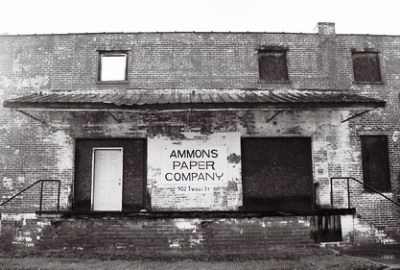
Back in April of 2005, when City of Dust posts were almost exclusively about the Central Savannah River Area, I wrote something regarding the neighborhood James Brown grew up in, a place once known as “The Terry,” a contraction of “Negro Territory.” I described this area, adjacent to downtown on the west and roughly bounded on the north by Walton Way and Laney Walker Boulevard to the south, as containing Augusta’s poorest and most dangerous streets. I also wrote about how, based on what I’d been told, I had decided not to go exploring those streets, which also meant I did not go looking for the childhood home of James Brown.
Shortly after publishing that post, someone by the name of Tawanda left a comment chastising me for believing what I’d been told. She said that the neighborhood was safe and, while people might be curious to know why I was walking around with a camera, no harm would come to me. Re-reading the original post, ACCESS DENIED, I have to say I'm embarrassed by what I wrote and Tawanda was absolutely right; I’d missed an opportunity to see more of Augusta and, what’s more, visit a neighborhood of great historical interest. I was foolish to be intimidated by what I’d heard. Happily, after a weekend visit to Augusta last week, I can now report that the area around James Brown’s childhood home is not a warzone. Further, to see the lot, and perhaps the actual house, where JB grew up was a real treat. So, without further ado, City of Dust returns to Augusta, Georgia:
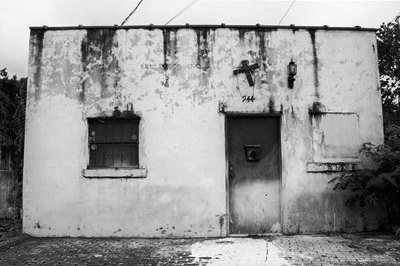
James Brown, Jr. was born in a one-room shack in Barnwell, South Carolina in either 1928 or 1933, although May 3, 1933 seems to be the most accepted date. His parents separated when he was four (some sources say two) and he didn't see his mother again for over two decades. When he was around six, he and his father moved to Augusta and James went to live with his Aunt Honey, who ran a brothel. There, James was reportedly beaten by johns, as well as his father. To pay his way, young James shined shoes and was also sent out to procure customers for his aunt. It is actually unclear from the information I found whether James' father ever lived in the brothel or if he resided elsewhere. In any case, James would have been staying at the address 944 Twiggs St. by the early-to-mid 1930's.
If you do a Google image search for “James Brown’s childhood home” the first photo of a structure you get is one from City of Dust that I can definitely tell you is not the place. However, in 2002, the UK’s Guardian newspaper published a long feature on James Brown by Philip Gourevitch entitled THE TRIP OF A LIFETIME. In it, Mr. Gourevitch is taken on a tour of James Brown’s old stomping grounds by JB himself. They drive around in James’ limo while the Godfather of Soul points out spots of interest, including his boyhood home (that's the lot, at least, in the photo above). I could summarize some of the article, but I think it’ll be more interesting to just plagiarize a few paragraphs:
Here was 944 Twiggs Street, the former brothel where he (i.e., James Brown) lived with his Aunt Honey, the madam - now abandoned and bristling with weeds. Here, by these train tracks, he buck-danced for soldiers passing through town at the start of the second world war; they'd throw him coins, which he took home to Aunt Honey: "Men made 30 cents an hour, 20 cents a hour, 15 cents a hour. I brought her back five dollars to pay the rent for a month." Here was the narrow canal where he once took refuge from the law: "Police were running me, and I saw 'em coming, and I made a few turns, jumped in the water, and breathed through a cane. I saw it in a movie." He mimicked the police, "Where'd he go? Where he at? Where he at? I know I saw him. I swear I saw that boy, Gawd damn." Then he recalled telling himself: "'Now listen up, it's either jail, either reform school, or you stay in the water.' So I stayed in the water." And here was an oil company that he used to rob when he was nine: "That was wrong but was survival."
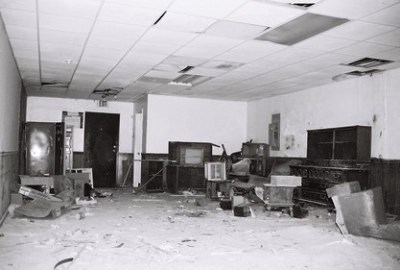
This is the best available information I’ve ever come across regarding the exact location of the brothel where James Brown grew up. Clearly, the place was not most recently a residence but a business of some kind (see above photo). Was the original home—perhaps a shotgun shack—converted for business use or was it torn down and replaced? Who knows? I do know that the building I photographed pre-dates the article, so, as James didn’t say otherwise, I might assume, with some reservation, that this is where JB grew up. (UPDATE: Twiggs St. was renumbered at some point, and Aunt Honey's brothel would've actually been next door, in a lot to the southwest that was a grassy patch with some trees last time I visited.) The remnants of the railroad tracks can still be seen nearby and, indeed, the canal runs right beside the house. It's fascinating to think that James hid from the police in that same canal all those years ago. Below is a photo of the Southern Milling Company complex, which recently caught fire. This is the view that young James would have seen from the front of his house, although not quite so singed.
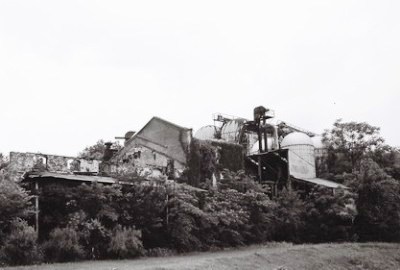
Here’s some more from the article:
As we turned off Twiggs Street on to a narrow and particularly abject strip, called Hopkins Street, Mr. Brown's mood turned sombre. The facade of a brick house on the corner was spray-painted with the words "Fuck the world," and farther along the real estate grew more dismal: Tottering clapboard bungalows, half of them burned out, and the rest, he said, "probably crack houses now. You come from that, you use crack." In this setting, the limo looked like a spaceship, but none of the street's ragtag residents expressed any surprise. They waved from sidewalks and porches, and although they couldn't see through the rain-streaked one-way glass, they called out: "Hello, Mr. Brown" and "God bless, Mr. Brown."
The vehicle could belong to nobody else: Every Thanksgiving, he comes through passing out turkeys, and at Christmas he brings toys. Now, he said, "They want me to help build this place back - What can I do? Get on my knees and pray, and ask, 'Mr. President, come - Mr. Bush, come in here and clean it out and put decent homes in here'?"
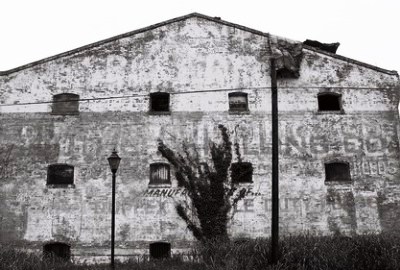
He told his driver to stop outside a broken-down shack, where an emaciated woman and two young men sat on a porch surrounded by household debris. One of the young men stepped forward in the rain, and Mr. Brown lowered his window and held out a $50 bill. The man bowed and withdrew. "Wait a minute," Mr. Brown called after him. "Y'all split that. Give that lady some, too." When he rolled his window up, he told me: "I'm not doin' this because you here. I wasn't gonna do it today. I didn't want you to see me handin' no money out there. I wasn't gonna do it. That's the honest-to-God truth." He sounded embarrassed. "You look at this, it kinda take your breath," he said.
At the end of the block, we reached JAMES BROWN BOULEVARD, and he said, "Out here on these same streets, you may see my daughter, and she has no business out here. She don't have to be there. I give her a home, she got a new Mercedes, and her Mercedes just sitting there. I can't give it to her, 'cause I can't - 'cause she shrug off everything I do."
Now, the picture painted by the article also makes the neighborhood sound dire. And I certainly saw a number of abandoned homes and businesses, some burnt down. But I never saw a single person that appeared menacing. Granted, the rain was pouring down the afternoon I was there, too, but mostly I saw a place where people were doing their best to get by, some in the face of admittedly long odds. There has also been considerable development along James Brown Blvd since James Brown or I last saw Augusta. The effects of this development on the larger neighborhood remain to be seen, but that a face-lift is occurring is undeniable.
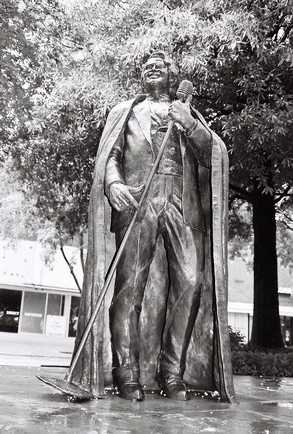 Again, I thank Tawanda for setting me straight and giving me the impetus to find James Brown’s childhood home. If anyone has more information on 944 Twiggs or James Brown’s early residences, please drop me a line. Tawanda, if you happen to read this, please get in touch. I wasn’t able to contact you on this trip, but I may be back in Augusta sometime down the road and would love to take you up on your kind offer of a full tour. Also, many thanks to Mr. Hughes for accompanying me on this outing and providing some historical insight of his own. His website archiving the available information on Henry Shultz and the lost city of HAMBURG SOUTH CAROLINA (site of the HAMBURG RIOT) is well worth spending some time with. The accompanying photo is of the James Brown monument on Broad Street in Augusta. The shot below is another look inside 944 Twiggs St.
Again, I thank Tawanda for setting me straight and giving me the impetus to find James Brown’s childhood home. If anyone has more information on 944 Twiggs or James Brown’s early residences, please drop me a line. Tawanda, if you happen to read this, please get in touch. I wasn’t able to contact you on this trip, but I may be back in Augusta sometime down the road and would love to take you up on your kind offer of a full tour. Also, many thanks to Mr. Hughes for accompanying me on this outing and providing some historical insight of his own. His website archiving the available information on Henry Shultz and the lost city of HAMBURG SOUTH CAROLINA (site of the HAMBURG RIOT) is well worth spending some time with. The accompanying photo is of the James Brown monument on Broad Street in Augusta. The shot below is another look inside 944 Twiggs St.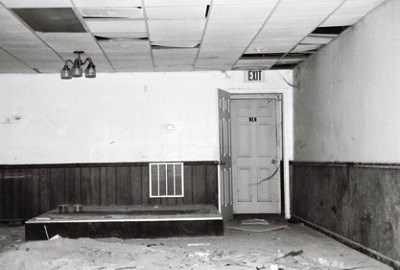
I think next time we’ll visit the mountainside Wild West gold-mining town of Jerome, Arizona and have a look at its famous, if hidden, “sliding” jail. Jerome is also the home of Maynard Keenan, the singer of Tool. Huh.